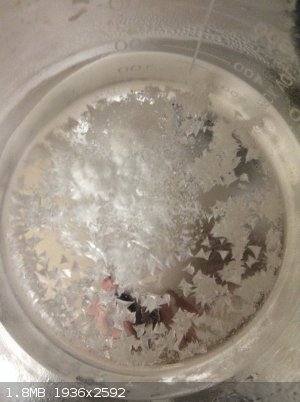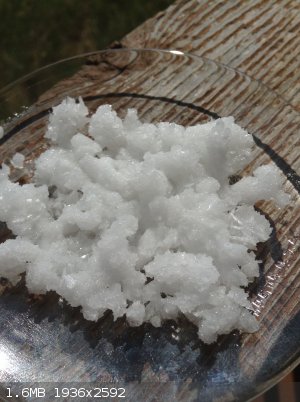Texium
Administrator
       
Posts: 4508
Registered: 11-1-2014
Location: Salt Lake City
Member Is Offline
Mood: PhD candidate!
|
|
Preparation of Potassium Antimony Tartrate
Yesterday I prepared the double salt potassium antimony tartrate. The following is a write-up of my procedure.
2 KC4H5O6 + Sb2O3 –>
K2Sb2(C4H2O6)2 • 3 H2O
18.82 grams of potassium bitartrate (cream of tartar) and 14.58 grams of pottery grade antimony trioxide were added to a 500 mL long necked Florence
flask (2:1 molar ratio, based on the formula of the double salt since I had nothing else to go on). To this, a magnetic stir bar and approximately 250
mL of distilled water were added. Then, the flask was placed on a hot plate and brought to a boil while stirring vigorously. After being brought to a
boil, the slurry was allowed to reflux for 30 minutes. After 30 minutes, most of the solids had dissolved, and this was especially apparent after
turning off the stirrer, and allowing the now reduced volume of solids to settle to the bottom of the flask. The solution was then filtered while hot
to remove any unreacted reagents that hadn't dissolved (heating the funnel is not necessary as long as it is not allowed to cool down too much before
filtering, as crystallization of this compound appears to be quite slow), and then transferred to a 600 mL beaker and placed in the freezer to
crystallize.
After about an hour and a half in the freezer, as the water in the beaker was beginning to freeze, a crop of pure white, glittery, triangular crystals
weighing 16.43 grams was recovered. A second group of crystals from the remaining solution is being crystallized now, albeit in the fridge at a slower
rate. The first picture shows the first crystals that were formed, making it easy to see they're neat triangular shape. The second picture shows the
full 16.43 grams. In a matter of time, I will post an update with a picture of the second batch of crystals.
 
[Edited on 7-23-2015 by zts16]
|
|
|
Oscilllator
National Hazard
   
Posts: 659
Registered: 8-10-2012
Location: The aqueous layer
Member Is Offline
Mood: No Mood
|
|
Very nice. I'm always amazed when a reaction comes up where a metal oxide somehow manages to get into solution without the use of strong acids or
bases.
Was the cream of tartar you used supermarket grade? If so, you might want to look out for anticaking agents and the like.
|
|
|
Texium
Administrator
       
Posts: 4508
Registered: 11-1-2014
Location: Salt Lake City
Member Is Offline
Mood: PhD candidate!
|
|
Yes, it was from the grocery store. If there was anything in there other than potassium bitartrate, it was most likely removed by either the
recrystallization or the filtration, as the crystals appear to be uniform and pure. The bottle didn't list ingredients though, so I don't know for
sure.
|
|
|
UC235
National Hazard
   
Posts: 565
Registered: 28-12-2014
Member Is Offline
Mood: No Mood
|
|
Quote: Originally posted by zts16  | | Yes, it was from the grocery store. If there was anything in there other than potassium bitartrate, it was most likely removed by either the
recrystallization or the filtration, as the crystals appear to be uniform and pure. The bottle didn't list ingredients though, so I don't know for
sure. |
I don't believe that "cream of tartar" typically has any anticake added. The solid is pretty nonhygroscopic and from what I remember of trying to make
rochelle salt with it, did not leave any solids after solution. It is also notably used as an anticake itself.
It's a waste product from the grape juice and wine industry. Chilling the juice causes it to crystallize out, and potassium bicarbonate may be added
to force precipitation of additional bitartrate in order to reduce acidity.
It's pretty easy to recrystallize as well from boiling water, though you will need a large solution volume since only about 6g will dissolve in 100ml
at boiling. You'll recover about 90% of that on cooling.
|
|
|
j_sum1
Administrator
       
Posts: 6218
Registered: 4-10-2014
Location: Unmoved
Member Is Offline
Mood: Organised
|
|
I don't have any antimony oxide, but I'd really like to try this. I think I'll attempt an analogue with Cr2O3.
I think also you should upload some nice crystal pix to Wikipedia. The article has some pictures but not the beautiful triagular crystals that you
have found.
https://en.wikipedia.org/wiki/Antimony_potassium_tartrate
|
|
|
Boffis
International Hazard
    
Posts: 1836
Registered: 1-5-2011
Member Is Offline
Mood: No Mood
|
|
Nice experiment! I like those triangular crystals too! Are they actually tetrahedron like Schlipp's salt (Na3SbS4)?
|
|
|
Texium
Administrator
       
Posts: 4508
Registered: 11-1-2014
Location: Salt Lake City
Member Is Offline
Mood: PhD candidate!
|
|
No, they aren't tetrahedral, they're actually flat, triangular plates. I haven't ever seen any crystals quite like these.
Also, I just made a page for it on the wiki: http://www.sciencemadness.org/smwiki/index.php/Potassium_ant...
As you can see, it's still lacking a lot of information, but I think it's already more useful than the Wikipedia page, from a home chemist's
perspective at least. I would have included more about chemical properties and other things, but there really isn't a whole lot out there about it
chemistry wise.
Also, I noticed that according to the structure and formula, the tartrates in this compound are not normal tartrate anions,
C4H4O6<sup>2-</sup>, but rather
C4H2O6<sup>4-</sup> with the two hydroxyl groups being deprotonated. I thought this
seemed rather interesting.
[Edited on 9-6-2015 by zts16]
|
|
|